Evaluating the Interconnectedness of the Sustainable Development Goals Based on the Causality Analysis of Sustainability Indicators
Abstract
:1. Introduction
2. The Sustainable Development Goals of the United Nations and Their Indicator-Based Monitoring
2.1. The Introduction of the Sustainable Development Goals and Indicators
2.2. The Availability of the Datasets of Sustainability Indicators
3. Cause-and-Effect Analysis Based Formation of the Indicator Network
3.1. Model Selection
3.2. Granger-Causality
3.3. The Network of the Causal Relationships
3.4. The Structure of the World3 Model
4. Results and Discussion
4.1. Causal Relationships in the World3 Model
4.2. The Interconnectedness of the Sustainable Development Goals of the United Nations in the View of Their Causal Relationships
4.2.1. Correlations between the Indicators
4.2.2. Selection of the Relevant Indicator Pairs
4.2.3. Modeling of the Time Series of the Indicators of the Sustainable Development Goals
4.2.4. Causal Loop Diagram of the Most Significant Causalities
4.3. Discussion and Future Work
- models of sustainability can be constructed (the process of constructing models of sustainability is discussed in [64]);
- systems for monitoring causality can be developed (the difficulties with regard to the selection of the most important indicators of SDGs and ignoring the redundant ones are discussed in [65]);
- the effectiveness of policymaking can be significantly improved by the identification of the expected cross-effects between SDGs; and
- the existing data assets and data quality can be described.
5. Conclusions
Supplementary Materials
Author Contributions
Funding
Acknowledgments
Conflicts of Interest
References
- Cucurachi, S.; Suh, S. Cause-effect analysis for sustainable development policy. Environ. Rev. 2017, 25, 358–379. [Google Scholar] [CrossRef] [Green Version]
- Cohen, M. A Systematic Review of Urban Sustainability Assessment Literature. Sustainability 2017, 9, 2408. [Google Scholar] [CrossRef]
- Choi, H.C.; Turk, E.S. Sustainability Indicators for Managing Community Tourism. In Quality-of-Life Community Indicators for Parks, Recreation and Tourism Management; Budruk, M., Phillips, R., Eds.; Springer: Dordrecht, The Netherlands, 2011; pp. 115–140. [Google Scholar]
- Lucato, W.C.; Santos, J.C.d.S.; Pacchini, A.P.T. Measuring the Sustainability of a Manufacturing Process: A Conceptual Framework. Sustainability 2018, 10, 81. [Google Scholar] [CrossRef]
- Moldan, B.; Janoušková, S.; Hák, T. How to understand and measure environmental sustainability: Indicators and targets. Ecol. Indic. 2012, 17, 4–13. [Google Scholar] [CrossRef]
- Otto-Zimmermann, K. From Rio to Rio+ 20: The changing role of local governments in the context of current global governance. Local Environ. 2012, 17, 511–516. [Google Scholar] [CrossRef]
- Griggs, D.; Stafford-Smith, M.; Gaffney, O.; Rockström, J.; Öhman, M.C.; Shyamsundar, P.; Steffen, W.; Glaser, G.; Kanie, N.; Noble, I. Policy: Sustainable development goals for people and planet. Nature 2013, 495, 305. [Google Scholar] [CrossRef] [PubMed]
- United Nations General Assembly (UNGA). Transforming Our World: The 2030 Agenda for Sustainable Development; A/RES/70/1; United Nations: New York, NY, USA, 2015; p. 35. [Google Scholar]
- Economic, U.; Council, S. Report of the inter-agency and expert group on sustainable development goal indicators. Stat. Comm. 2016, 13. [Google Scholar]
- Bakshi, B.R.; Gutowski, T.G.; Sekulic, D.P. Claiming Sustainability: Requirements and Challenges. ACS Sustain. Chem. Eng. 2018, 6, 3632–3639. [Google Scholar] [CrossRef]
- Le Blanc, D. Towards integration at last? The sustainable development goals as a network of targets. Sustain. Dev. 2015, 23, 176–187. [Google Scholar] [CrossRef]
- Griggs, D.; Nilsson, M.; Stevance, A.; McCollum, D. A Guide to SDG Interactions: From Science to Implementation; International Council for Science: Paris, France, 2017. [Google Scholar]
- Nilsson, M.; Griggs, D.; Visbeck, M. Map the interactions between sustainable development goals: Mans Nilsson, Dave Griggs and Martin Visbeck present a simple way of rating relationships between the targets to highlight priorities for integrated policy. Nature 2016, 534, 320–323. [Google Scholar] [CrossRef] [PubMed]
- Hajer, M.; Nilsson, M.; Raworth, K.; Bakker, P.; Berkhout, F.; de Boer, Y.; Rockström, J.; Ludwig, K.; Kok, M. Beyond cockpit-ism: Four insights to enhance the transformative potential of the sustainable development goals. Sustainability 2015, 7, 1651–1660. [Google Scholar] [CrossRef] [Green Version]
- Bell, S.; Morse, S. Sustainability Indicators Past and Present: What Next? Sustainability 2018, 10, 1688. [Google Scholar] [CrossRef]
- Organization, W.H. World Health Statistics 2016: Monitoring Health for the SDGs Sustainable Development Goals; World Health Organization: Geneva, Switzerland, 2016. [Google Scholar]
- Spangenberg, J.H. Hot Air or Comprehensive Progress? A Critical Assessment of the SDGs. Sustain. Dev. 2017, 25, 311–321. [Google Scholar] [CrossRef]
- Omri, A.; Nguyen, D.K.; Rault, C. Causal interactions between CO2 emissions, FDI, and economic growth: Evidence from dynamic simultaneous-equation models. Econ. Model. 2014, 42, 382–389. [Google Scholar] [CrossRef]
- Soytas, U.; Sarı, R.; Ewing, B. Energy consumption, income, and carbon emissions in the United States. Ecol. Econ. 2007, 62, 482–489. [Google Scholar] [CrossRef]
- Stephens, P.A.; Pettorelli, N.; Barlow, J.; Whittingham, M.J.; Cadotte, M.W. Management by proxy? The use of indices in applied ecology. J. Appl. Ecol. 2015, 52, 1–6. [Google Scholar] [CrossRef] [Green Version]
- Maxim, L.; van der Sluijs, J.P. Quality in environmental science for policy: Assessing uncertainty as a component of policy analysis. Environ. Sci. Policy 2011, 14, 482–492. [Google Scholar] [CrossRef]
- Kajikawa, Y.; Ohno, J.; Takeda, Y.; Matsushima, K.; Komiyama, H. Creating an academic landscape of sustainability science: An analysis of the citation network. Sustain. Sci. 2007, 2, 221. [Google Scholar] [CrossRef]
- Ward, H. International linkages and environmental sustainability: The effectiveness of the regime network. J. Peace Res. 2006, 43, 149–166. [Google Scholar] [CrossRef]
- Park, S.; Lee, S.J.; Jun, S. A network analysis model for selecting sustainable technology. Sustainability 2015, 7, 13126–13141. [Google Scholar] [CrossRef]
- Niemeijer, D.; de Groot, R.S. Framing environmental indicators: Moving from causal chains to causal networks. Environ. Dev. Sustain. 2008, 10, 89–106. [Google Scholar] [CrossRef]
- Billio, M.; Getmansky, M.; Lo, A.W.; Pelizzon, L. Econometric measures of connectedness and systemic risk in the finance and insurance sectors. J. Financ. Econ. 2012, 104, 535–559. [Google Scholar] [CrossRef] [Green Version]
- Rubinov, M.; Sporns, O. Complex network measures of brain connectivity: Uses and interpretations. NeuroImage 2010, 52, 1059–1069. [Google Scholar] [CrossRef] [PubMed]
- Meadows, D.; de Rome, C.; Associates, P. The Limits to Growth: A Report for the Club of Rome’s Project on the Predicament of Mankind; Universe Books: New York, New York, 1972. [Google Scholar]
- Global SDG Indicators Database. Available online: https://unstats.un.org/sdgs/indicators/database/ (accessed on 18 June 2018).
- Resolution Adopted by the General Assembly on 6 July 2017 (A/RES/71/313). Available online: https://undocs.org/A/RES/71/313 (accessed on 12 June 2018).
- Progress towards the Sustainable Development Goals. Available online: https://unstats.un.org/sdgs/files/report/2017/secretary-general-sdg-report-2017--Statistical-Annex.pdf (accessed on 24 May 2018).
- Janoušková, S.; Hák, T.; Moldan, B. Global SDGs Assessments: Helping or Confusing Indicators? Sustainability 2018, 10, 1540. [Google Scholar] [CrossRef]
- Cheung, Y.W.; Lai, K.S. Lag Order and Critical Values of the Augmented Dickey–Fuller Test. J. Bus. Econ. Stat. 1995, 13, 277–280. [Google Scholar] [CrossRef]
- Phillips, P.C.B.; Perron, P. Testing for a unit root in time series regression. Biometrika 1988, 75, 335–346. [Google Scholar] [CrossRef]
- Kwiatkowski, D.; Phillips, P.C.; Schmidt, P.; Shin, Y. Testing the null hypothesis of stationarity against the alternative of a unit root: How sure are we that economic time series have a unit root? J. Econ. 1992, 54, 159–178. [Google Scholar] [CrossRef]
- Hylleberg, S.; Engle, R.; Granger, C.; Yoo, B. Seasonal integration and cointegration. J. Econ. 1990, 44, 215–238. [Google Scholar] [CrossRef]
- Toda, H.Y.; Yamamoto, T. Statistical inference in vector autoregressions with possibly integrated processes. J. Econ. 1995, 66, 225–250. [Google Scholar] [CrossRef]
- Taku, Y.; Eiji, K. Tests for Long-Run Granger Non-Causality in Cointegrated Systems. J. Time Ser. Anal. 2006, 27, 703–723. [Google Scholar] [CrossRef] [Green Version]
- Rajaguru, G.; Abeysinghe, T. Temporal aggregation, cointegration and causality inference. Econ. Lett. 2008, 101, 223–226. [Google Scholar] [CrossRef]
- Rajaguru, G.; O’Neill, M.; Abeysinghe, T. Does Systematic Sampling Preserve Granger Causality with an Application to High Frequency Financial Data? Econometrics 2018, 6, 31. [Google Scholar] [CrossRef]
- Barnett, L.; Seth, A.K. The MVGC multivariate Granger causality toolbox: A new approach to Granger-causal inference. J. Neurosci. Methods 2014, 223, 50–68. [Google Scholar] [CrossRef] [PubMed] [Green Version]
- Granger, C. Investigating Causal Relations by Econometric Models and Cross-Spectral Methods. Econometrica 1969, 37, 424–438. [Google Scholar] [CrossRef]
- Hsiao, C. Autoregressive modeling and causal ordering of economic variables. J. Econ. Dyn. Control 1982, 4, 243–259. [Google Scholar] [CrossRef]
- Schwarz, G. Estimating the Dimension of a Model. Ann. Stat. 1978, 6, 461–464. [Google Scholar] [CrossRef]
- Duan, P.; Yang, F.; Chen, T.; Shah, S.L. Direct Causality Detection via the Transfer Entropy Approach. IEEE Trans. Control Syst. Technol. 2013, 21, 2052–2066. [Google Scholar] [CrossRef]
- Sun, X. Assessing Nonlinear Granger Causality from Multivariate Time Series. In Machine Learning and Knowledge Discovery in Databases; Daelemans, W., Goethals, B., Morik, K., Eds.; Springer: Berlin/Heidelberg, Germany, 2008; pp. 440–455. [Google Scholar]
- Aho, A.; Garey, M.; Ullman, J. The Transitive Reduction of a Directed Graph. SIAM J. Comput. 1972, 1, 131–137. [Google Scholar] [CrossRef]
- Nagarjuna, G. Collaborative Creation of Teaching-Learning Sequences and an Atlas of Knowledge. Math. Teach.-Res. J. Online 2009, 3, 23. [Google Scholar]
- Prim, R.C. Shortest Connection Networks And Some Generalizations. Bell Syst. Tech. J. 1957, 36, 1389–1401. [Google Scholar] [CrossRef]
- Forrester, J. World Dynamics; Wright-Allen Press, Inc.: Cambridge, MS, USA, 1971. [Google Scholar]
- Meadows, D.; Meadows, D.; Randers, J. Beyond the Limits: Global Collapse Or a Sustainable Future; Earthscan Publications: London, UK, 1992. [Google Scholar]
- Meadows, D.; Randers, J.; Meadows, D. The Limits to Growth: The 30-Year Update; Earthscan Publications: London, UK, 2004. [Google Scholar]
- Simonovic, S.P. World water dynamics: Global modeling of water resources. J. Environ. Manag. 2002, 66, 249–267. [Google Scholar] [CrossRef]
- Pasqualino, R.; Jones, A.W.; Monasterolo, I.; Phillips, A. Understanding Global Systems Today—A Calibration of the World3-03 Model between 1995 and 2012. Sustainability 2015, 7, 9864–9889. [Google Scholar] [CrossRef] [Green Version]
- The World3 Model: A Detailed World Forecaster, Insight Maker model. Available online: https://insightmaker.com/insight/92391/Clone-of-The-World3-Model-A-Detailed-World-Forecaster (accessed on 22 May 2018).
- Dorgo, G.; Honti, G.; Abonyi, J. Automated Analysis of the Interactions Between Sustainable Development Goals Extracted from Models and Texts of Sustainability Science. Chem. Eng. Trans. 2018, 70, 781–786. [Google Scholar]
- Bastianoni, S.; Coscieme, L.; Caro, D.; Marchettini, N.; Pulselli, F.M. The needs of sustainability: The overarching contribution of systems approach. Ecol. Indic. 2018, in press. [Google Scholar] [CrossRef]
- WHO/UNICEF. Progress on Drinking-Water and Sanitation: Special Focus on Sanitation; WHO/UNICEF: Geneva, Switzerland, 2008. [Google Scholar]
- Hutton, G.; Haller, L. Evaluation of the Costs and Benefits of Water and Sanitation Improvements at the Global Level; World Health Organization: Geneva, Switzerland, 2004. [Google Scholar]
- Dora, C.; Haines, A.; Balbus, J.; Fletcher, E.; Adair-Rohani, H.; Alabaster, G.; Hossain, R.; de Onis, M.; Branca, F.; Neira, M. Indicators linking health and sustainability in the post-2015 development agenda. Lancet 2015, 385, 380–391. [Google Scholar] [CrossRef]
- Fosu, A.K. Growth, inequality and poverty in Sub-Saharan Africa: Recent progress in a global context. Oxf. Dev. Stud. 2015, 43, 44–59. [Google Scholar] [CrossRef]
- Ostrom, E. A general framework for analyzing sustainability of social-ecological systems. Science 2009, 325, 419–422. [Google Scholar] [CrossRef] [PubMed]
- Pope, F.; McDonagh, S. On Care for Our Common Home: Laudato Si’—The Encyclical of Pope Francis on the Environment; Orbis Books (Ecology and Justice): New York, NY, USA, 2016. [Google Scholar]
- Faucheux, S.; Pearce, D.; Proops, J. (Eds.) Models of Sustainable Development; Edward Elgar Publishing: Cheltenham, UK, 1996. [Google Scholar]
- Reyers, B.; Stafford-Smith, M.; Erb, K.H.; Scholes, R.J.; Selomane, O. Essential Variables help to focus Sustainable Development Goals monitoring. Curr. Opin. Environ. Sustain. 2017, 26–27, 97–105. [Google Scholar] [CrossRef]
- High Level Political Forum on Sustainable Development. Handbook for Preparation of Voluntary National Reviews, 2018. Available online: https://sustainabledevelopment.un.org/content/documents/17354VNR_handbook_2018.pdf (accessed on 5 October 2018).
- Platform, S.D.K. Synthesis of the Main Messages of the Reports of the Voluntary National Reviews, 2018. Available online: https://sustainabledevelopment.un.org/content/documents/20027SynthesisofMainMessages2018_0607.pdf (accessed on 27 July 2018).
- Report of the Secretary-General. Critical Milestones towards Coherent, Efficient and Inclusive Follow-up and Review at the Global Level. Available online: http://www.un.org/ga/search/view_doc.asp?symbol=A/70/684&Lang=E (accessed on 5 October 2018).
- Inter-Agency and Expert Group on Sustainable Development Goal Indicators (IAEG-SDGs). Available online: https://unstats.un.org/sdgs/files/meetings/iaeg-sdgs-meeting-08/8th%20IAEG%20SDG%20Meeting%20Plenary%20Session%20Tentative%20Agenda_07.08.2018.pdf (accessed on 5 October 2018).

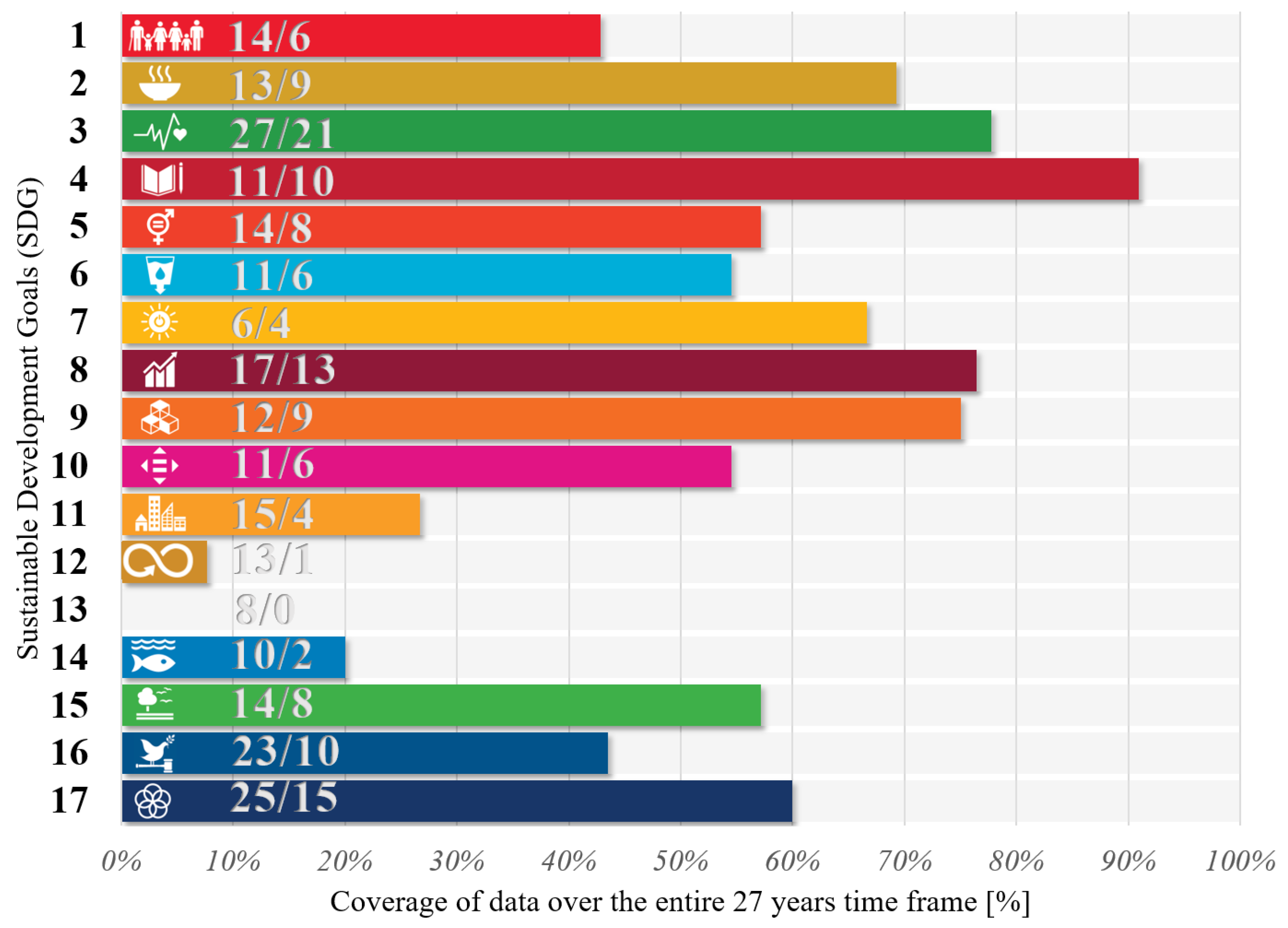
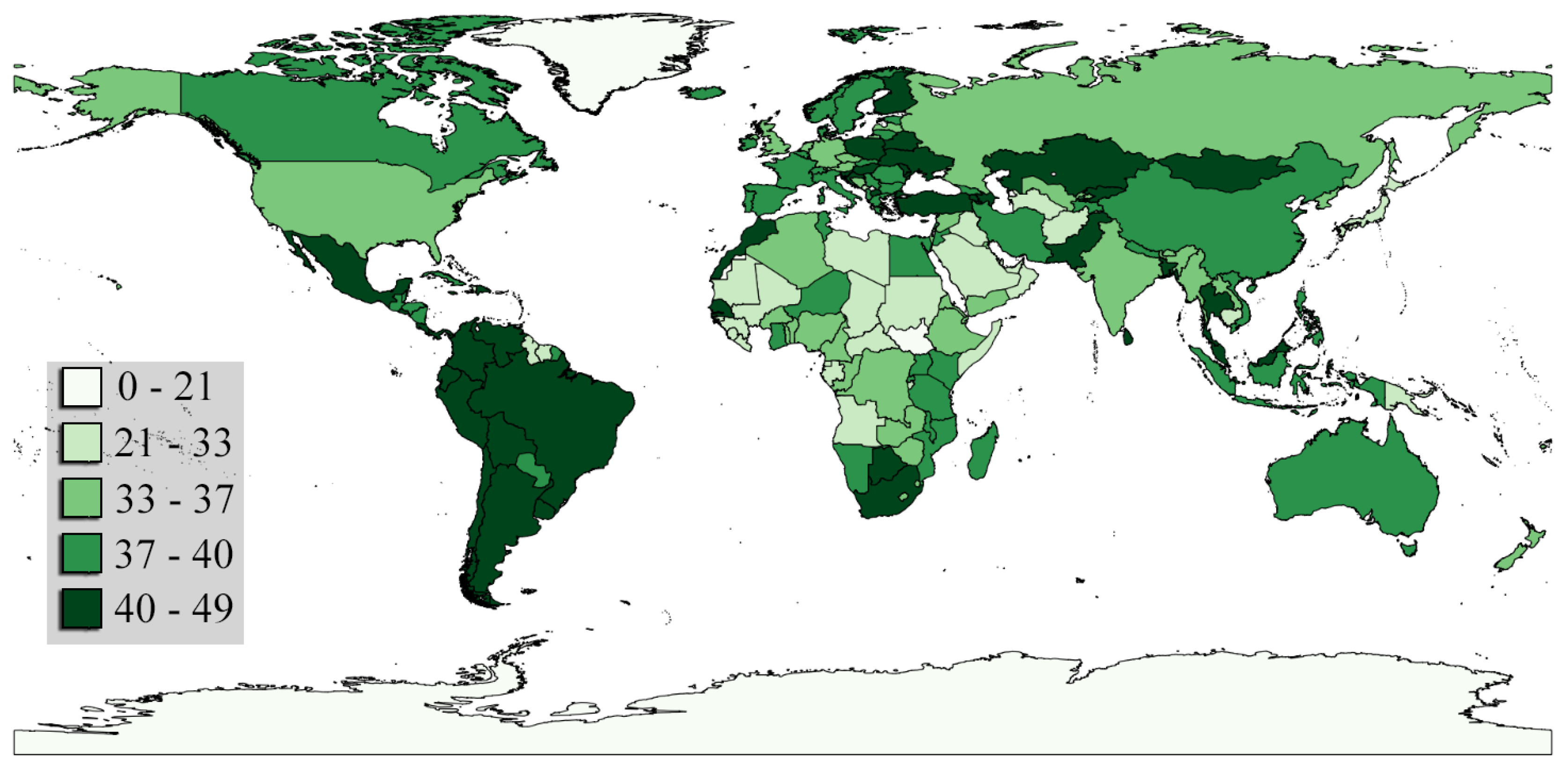
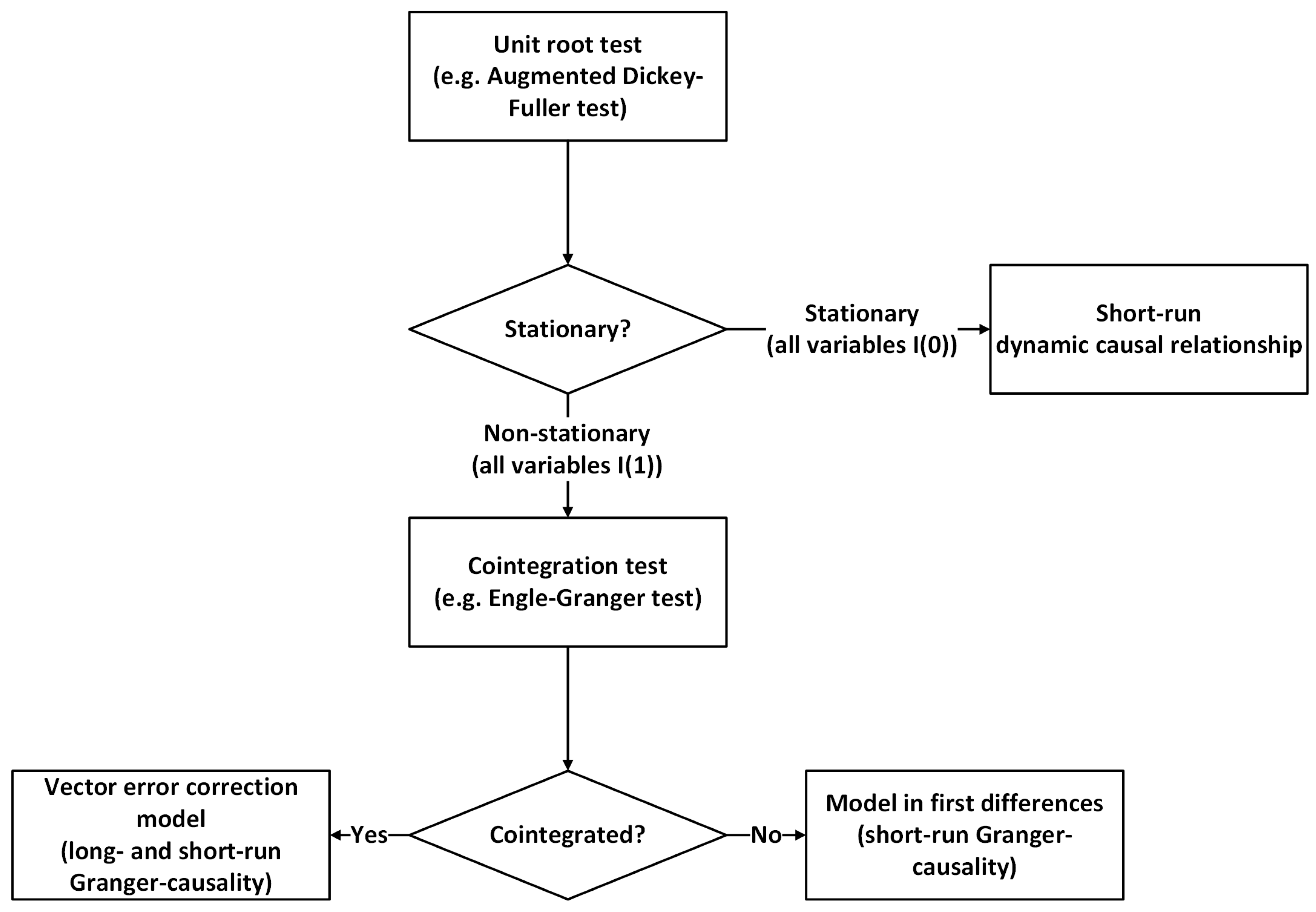


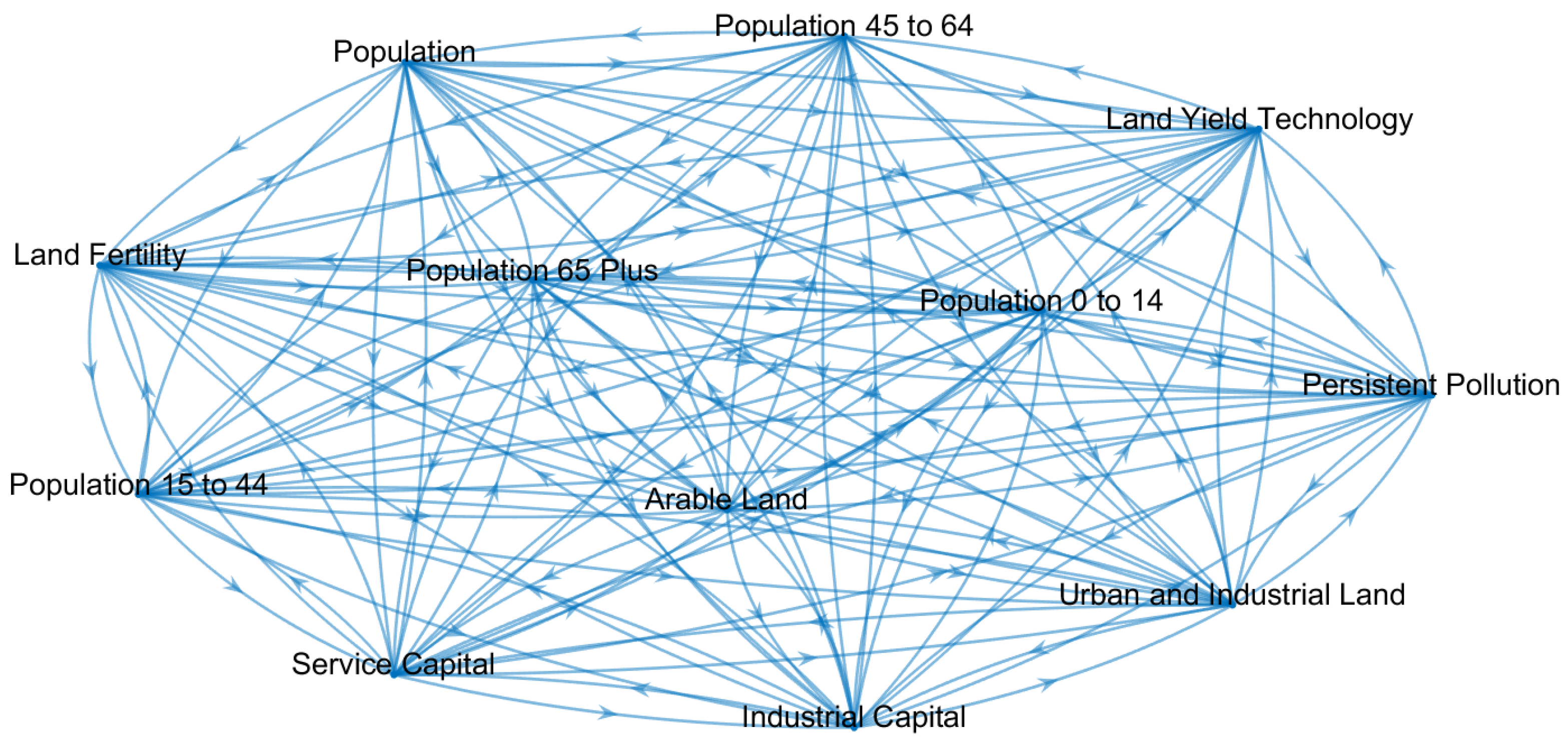
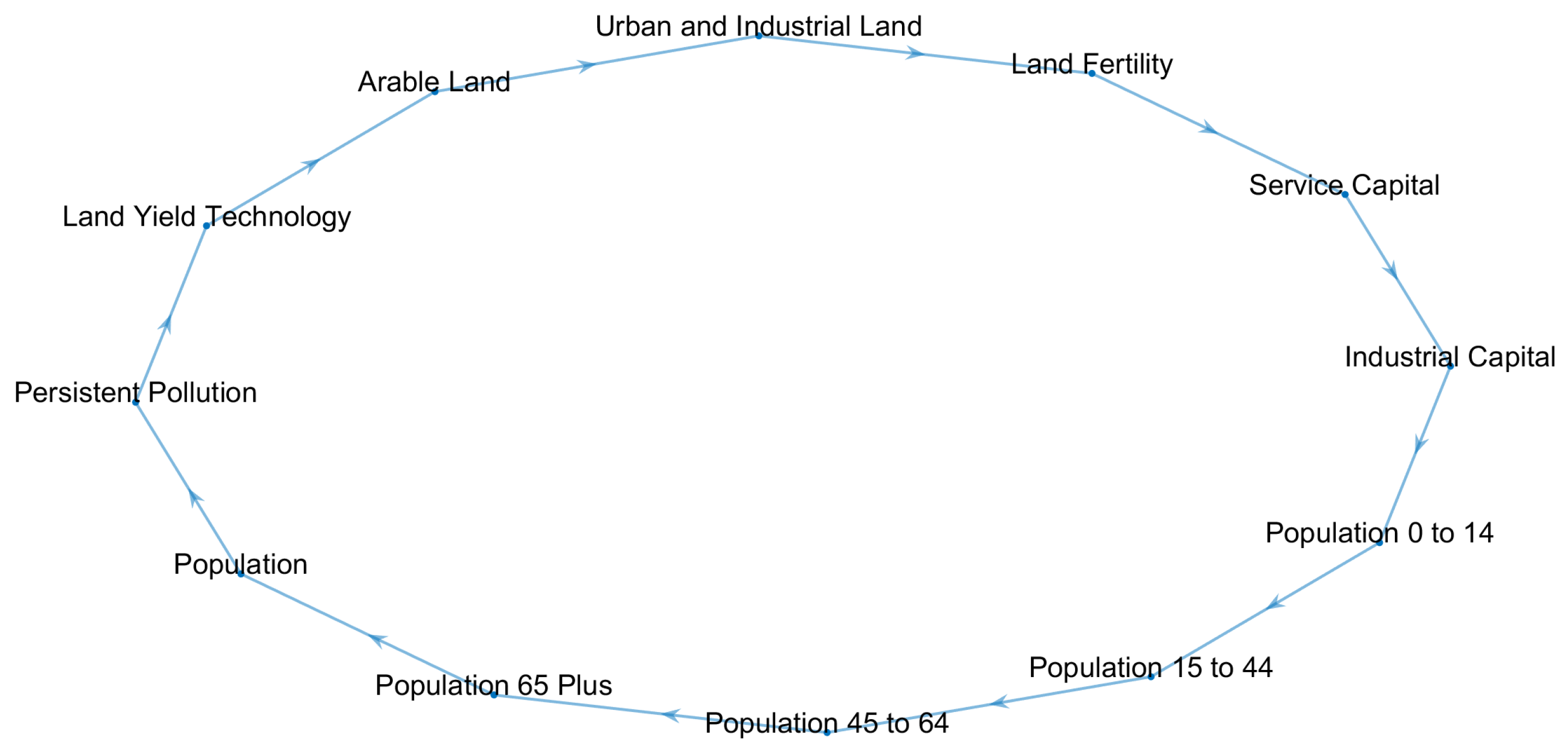
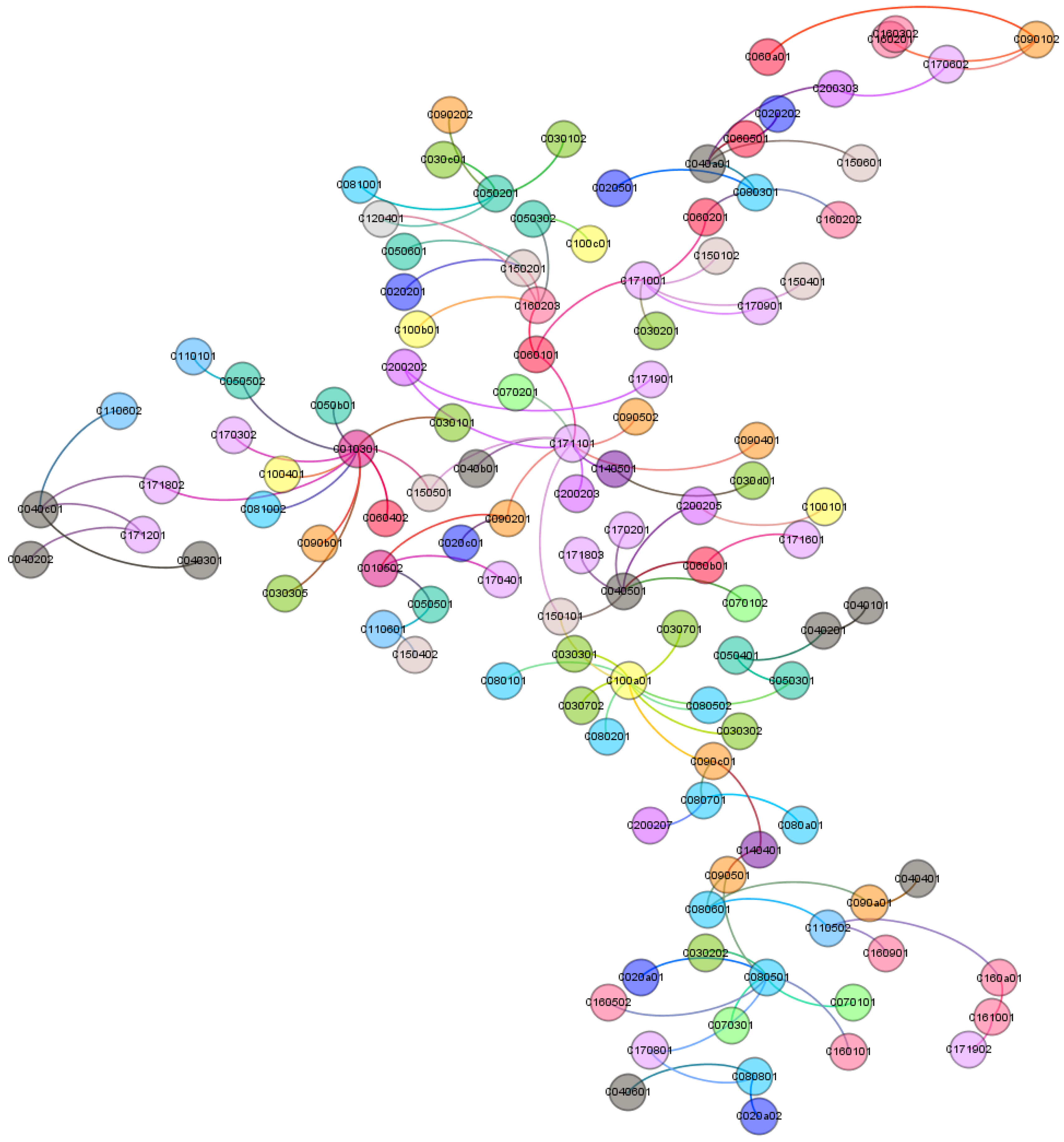
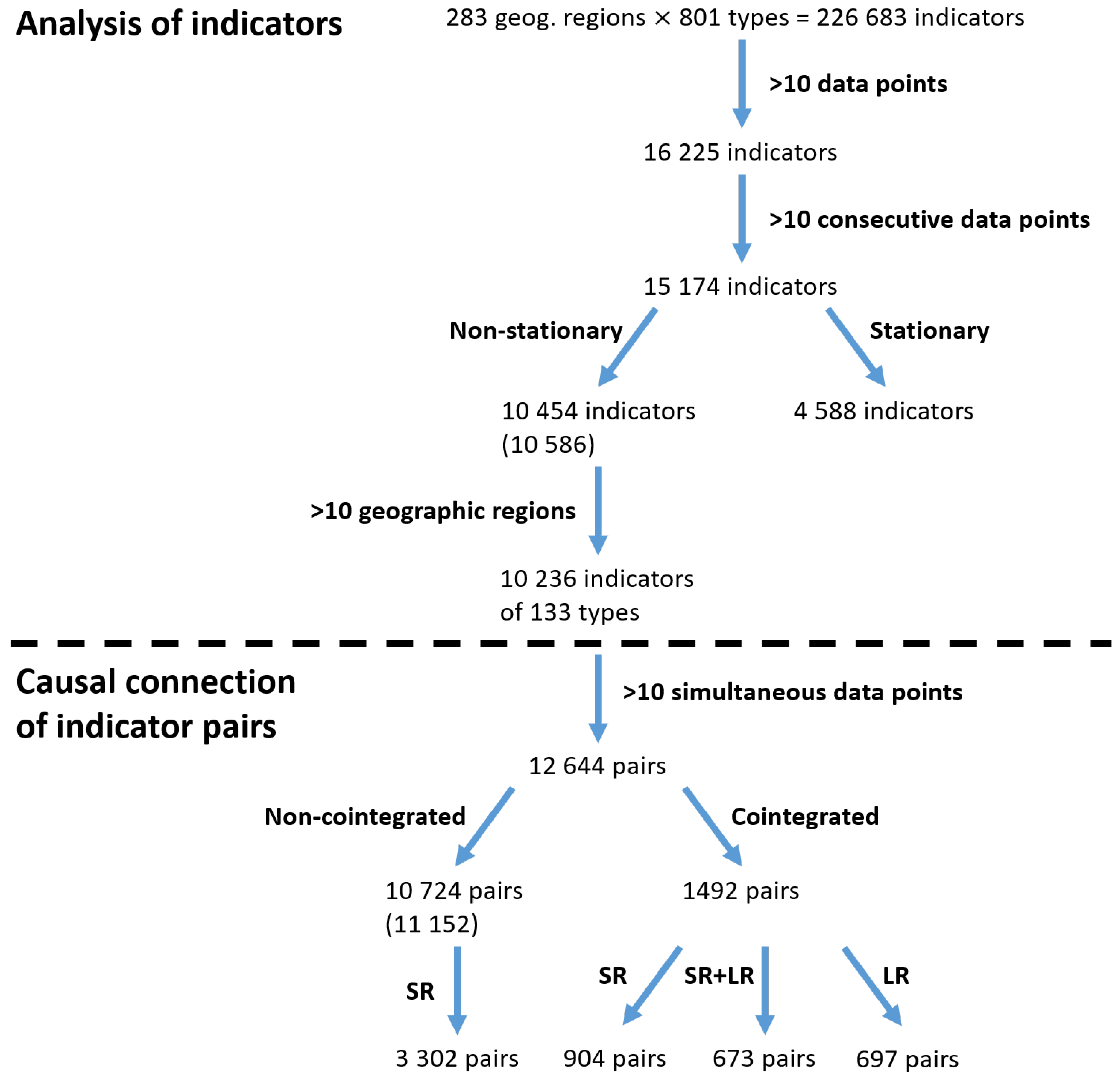
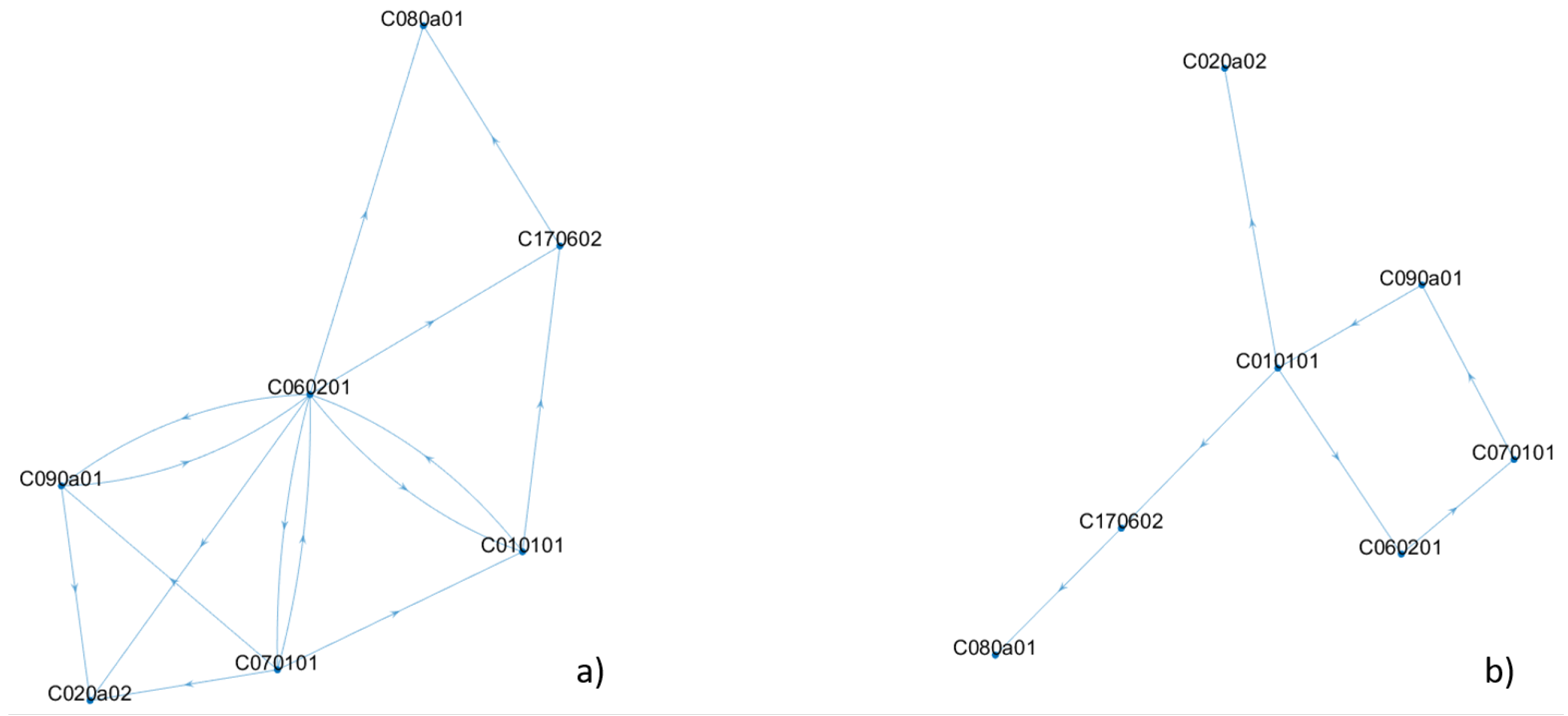
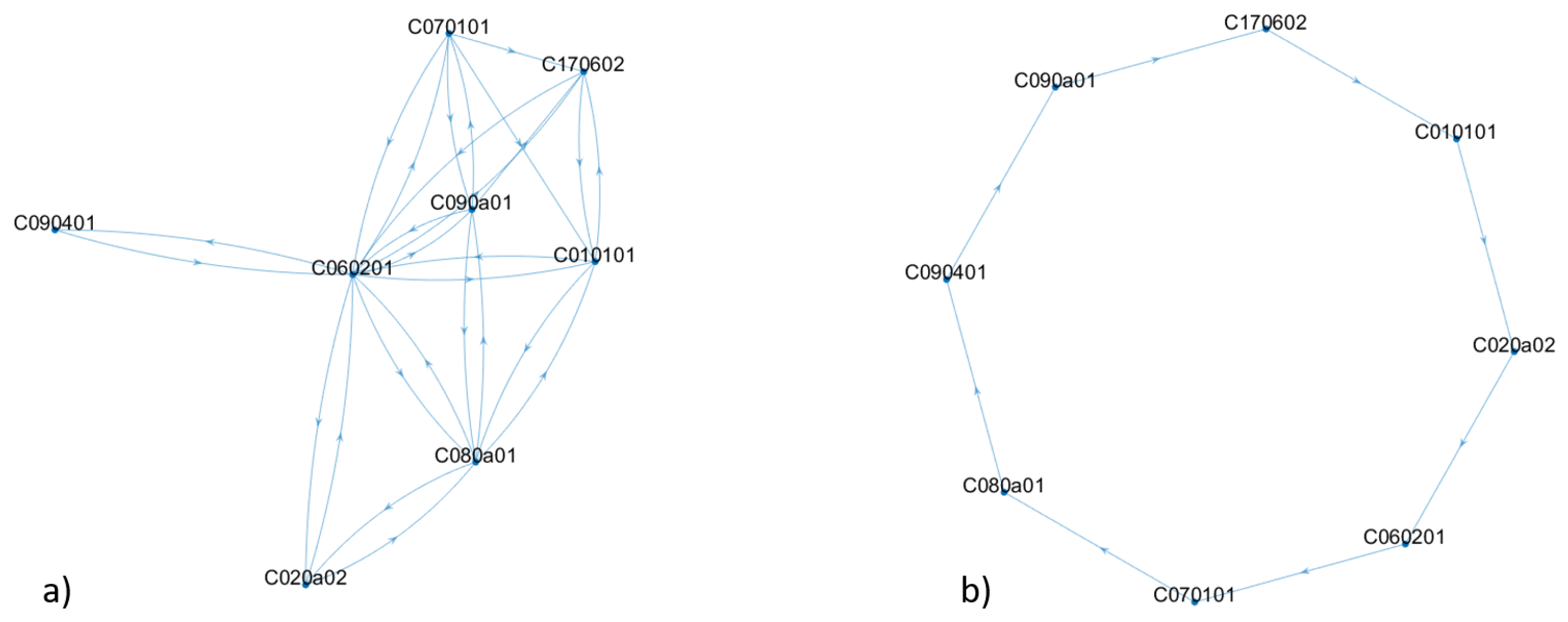
| Cause Variable | Effect Variable | ECT (t-Stats) | Joint Short- and Long-Rung Causality (F-Stats) |
|---|---|---|---|
| Land Yield Technology | Population 0 to 14 | −7.1905 (p < 0.0005) | 44,381 (p < 0.0005) |
| Indicator Code | Indicator Description | Indicator Code | Indicator Description |
|---|---|---|---|
| C060b01 | Proportion of local administrative units with established and operational policies and procedures for participation of local communities in water and sanitation management | C171601 | Number of countries reporting progress in multi-stakeholder development effectiveness monitoring frameworks that support the achievement of the sustainable development goals |
| C171101 | Developing countries and least developed countries share of global exports | C090201 | Manufacturing value added as a proportion of GDP and per capita |
| C171101 | Developing countries and least developed countries share of global exports | C090401 | emission per unit of value added |
| C171001 | Worldwide weighted tariff-average | C170901 | Dollar value of financial and technical assistance (including through North–South, South–South and triangular cooperation) committed to developing countries |
| C200203 | Domestic material consumption, domestic material consumption per capita, and domestic material consumption per GDP | C171101 | Developing countries and least developed countries share of global exports |
| Cause | Description of the Cause | Effect | Description of the Effect |
|---|---|---|---|
| C010101 | Proportion of population below the international poverty line, by sex, age, employment status and geographical location (urban/rural) | C060201 | Proportion of population using safely managed sanitation services, including a hand-washing facility with soap and water |
| C060201 | Proportion of population using safely managed sanitation services, including a hand-washing facility with soap and water | C010101 | Proportion of population below the international poverty line, by sex, age, employment status and geographical location (urban/rural) |
| C010101 | Proportion of population below the international poverty line, by sex, age, employment status and geographical location (urban/rural) | C170602 | Fixed Internet broadband subscriptions per 100 inhabitants, by speed |
| C070101 | Proportion of population with access to electricity | C010101 | Proportion of population below the international poverty line, by sex, age, employment status and geographical location (urban/rural) |
| C060201 | Proportion of population using safely managed sanitation services, including a hand-washing facility with soap and water | C020a02 | Total official flows (official development assistance plus other official flows) to the agriculture sector |
| Cause | Description of the Cause | Effect | Description of the Effect |
|---|---|---|---|
| C060201 | Proportion of population using safely managed sanitation services, including a hand-washing facility with soap and water | C090a01 | Total official international support (official development assistance plus other official flows) to infrastructure |
| C090a01 | Total official international support (official development assistance plus other official flows) to infrastructure | C060201 | Proportion of population using safely managed sanitation services, including a hand-washing facility with soap and water |
| C060201 | Proportion of population using safely managed sanitation services, including a hand-washing facility with soap and water | C080a01 | Aid for Trade commitments and disbursements |
| C060201 | Proportion of population using safely managed sanitation services, including a hand-washing facility with soap and water | C010101 | Proportion of population below the international poverty line, by sex, age, employment status and geographical location (urban/rural) |
| C010101 | Proportion of population below the international poverty line, by sex, age, employment status and geographical location (urban/rural) | C060201 | Proportion of population using safely managed sanitation services, including a hand-washing facility with soap and water |
| C060201 | Proportion of population using safely managed sanitation services, including a hand-washing facility with soap and water | C020a02 | Total official flows (official development assistance plus other official flows) to the agriculture sector |
| Indicator Code | Indicator Description | Node Centrality |
|---|---|---|
| C060201 | Proportion of population using safely managed sanitation services, including a hand-washing facility with soap and water | 0.143 |
| C070101 | Proportion of population with access to electricity | 0.100 |
| C080a01 | Aid for Trade commitments and disbursements | 0.100 |
| C090a01 | Total official international support (official development assistance plus other official flows) to infrastructure | 0.100 |
| C010101 | Proportion of population below the international poverty line, by sex, age, employment status and geographical location (urban/rural) | 0.091 |
| C020a02 | Total official flows (official development assistance plus other official flows) to the agriculture sector | 0.083 |
| C170602 | Fixed Internet broadband subscriptions per 100 inhabitants, by speed | 0.083 |
| C090401 | CO2 emission per unit of value added | 0.077 |
© 2018 by the authors. Licensee MDPI, Basel, Switzerland. This article is an open access article distributed under the terms and conditions of the Creative Commons Attribution (CC BY) license (http://creativecommons.org/licenses/by/4.0/).
Share and Cite
Dörgő, G.; Sebestyén, V.; Abonyi, J. Evaluating the Interconnectedness of the Sustainable Development Goals Based on the Causality Analysis of Sustainability Indicators. Sustainability 2018, 10, 3766. https://doi.org/10.3390/su10103766
Dörgő G, Sebestyén V, Abonyi J. Evaluating the Interconnectedness of the Sustainable Development Goals Based on the Causality Analysis of Sustainability Indicators. Sustainability. 2018; 10(10):3766. https://doi.org/10.3390/su10103766
Chicago/Turabian StyleDörgő, Gyula, Viktor Sebestyén, and János Abonyi. 2018. "Evaluating the Interconnectedness of the Sustainable Development Goals Based on the Causality Analysis of Sustainability Indicators" Sustainability 10, no. 10: 3766. https://doi.org/10.3390/su10103766







